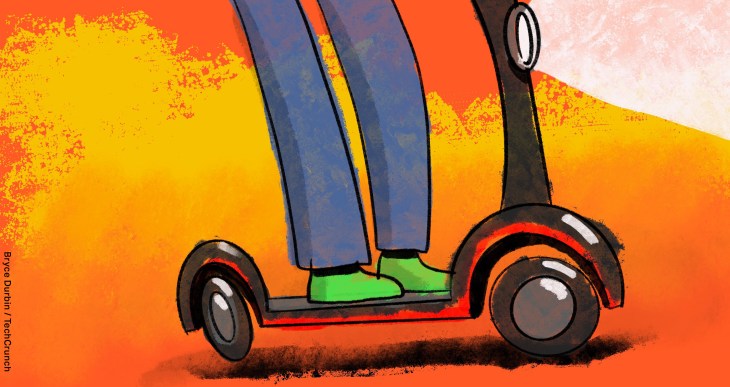Since its inception, shared micromobility services have been in a precarious position — one supported by millions of dollars in venture capital. But the COVID-19 pandemic has brought even more turmoil upon an industry that has long struggled with unit economics. It has led to mass layoffs, operation shutdowns across several markets and more consolidation.
Despite the struggles of individual operators, micromobility as technology will come out of this stronger than before, industry analyst Horace Dediu tells TechCrunch.
Dediu, an analyst who coined the term “micromobility” and founded Micromobility Industries, sees the silver lining in the pandemic for micromobility as it relates to the adoption of public transit alternatives. With ongoing concerns about the disease and social distancing, consumers may look to alternative modes of transportation — ones that require fewer interactions with strangers. But simply because a certain technology takes off doesn’t mean the current slate of operators will benefit.
“The companies involved may not survive a crisis,” Dediu says. “We don’t remember the fact there were 3,000 automobile companies in the United States prior to Henry Ford’s Model T. We don’t remember all the electrical suppliers out there and the consolidation that took place in the electrical field with Westinghouse. There’s a lot of historic references we can cite. But the fact of the matter is that up until the crisis there was an over-investment where probably too much capital was allocated to the industry chasing business models which are not sustainable…I think there will be a washout with a kind of consolidation and we’re seeing that already.”
Earlier this month, for example, Uber sold off JUMP to Lime, while simultaneously leading a $170 million investment in the micromobility startup. That funding round brought Lime’s valuation down 79%, to $510 million, according to The Information. Last April, Lime was valued at $2.4 billion.
Shortly before Lime announced the funding, the company laid off 13% of its workforce amid the pandemic. Those layoffs came just a few months after the startup laid off about 14% of its workforce and ceased operations in 12 markets.
Before the pandemic hit, Bird had already acquired Scoot in July 2019 and Circ in January 2020. Amid the pandemic in April, however, Bird laid off about 30% of its workforce.
As Trucks VC Partner Kate Schox previously told TechCrunch, the companies most at risk during these times are “any mobility hardware startups with fleets of vehicles that are grounded and their business model depends on high utilization (micromobility, motor coaches, airplanes, etc.).”
But struggling companies don’t necessarily equate with a struggling industry as a whole. Even if some companies ultimately shut down, there is still room for personal ownership of micromobility, as well as room for other, more stable companies to pick up where others left off.
“There may be a shift to personally owned micromobility,” Autotech Ventures Partner Jeff Peters recently told TechCrunch. “Perhaps people will realize it is more cost-effective to just buy a scooter or bike, and they don’t need to worry about sanitation.”
In New York, we’ve already seen more people biking amid the pandemic. In March, Citi Bike reported demand had increased 67% between March 1 and March 11 compared to the same period in 2019.
Moving forward, venture capitalists Stonly Baptiste and Shaun Abrahamson of Urban.us said they envision even more bike adoption.
“We will likely see more bike adoption, and the demand will hopefully drive new innovation in bike forms for more security, safety and portability,” they told TechCrunch. “And naturally, we are excited about Onewheel and other ‘owned’ light EVs’ growing presence in urban mobility.”
Micromobility versus public transit
The big question right now for Dediu is whether public transit ridership will return to normal, and, if not, whether it’s an opportunity for micromobility to fill that gap.
Worldwide, the coronavirus has disrupted demand and ridership for public transit. Ridership in major cities in the U.S., Europe and China are down by 50-90%, according to City Lab. New York’s regional Metro North commuter rail, for example, dropped 95% and Bay Area Rapid Transit in Northern California operated with 93% fewer riders than usual earlier this month. A decrease in ridership has led many public transit operators to drastically reduce service, which means many are facing major declines in revenue. And given potential difficulties with social distancing on public transit, some are predicting more people will be getting into personal cars in a post-pandemic world. Dediu is not one of those people.
“Transit moves a lot of people,” Dediu says. “To substitute that many people with automobiles — it’s incredible how much more street space parking and time is necessary. Switching to a car means you need to spend more money. Secondly, it’s going to take more time because a car needs to be parked wherever its destination may be.”
Parking in the pre-pandemic world was already difficult in many major cities, so imagine accommodating even 10% more cars, Dediu says.
“If you don’t have parking, you don’t have cars,” he says. “Period. So the problem with people suggesting that we’re going to drive instead of take the bus or the subway — they have to answer these three questions: Where’s the money coming from? Where’s the time coming from? And where’s the space coming from?”
With micromobility, assuming the journeys are short enough, you don’t have to worry about traffic, parking and high costs of gas, insurance and car payments, Dediu says. It’s not that micromobility will replace all of the public transit trips, but even 1-2% of transit trips going to micromobility would make it 10 times bigger, Dediu estimates.
“I’m still trying to work out the exact numbers,” he says. “These are still rough numbers, but that’s the opportunity right now. We don’t need to see everybody jump on a scooter or a bike, but we need to convince just a few people. That’s all we need to see and as that snowball grows, you know, it just grows and grows.”

